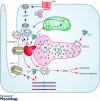Intracellular calcium release channels: an update
- PMID: 28303572
- PMCID: PMC5430224
- DOI: 10.1113/JP272781
Intracellular calcium release channels: an update
Abstract
Ryanodine receptors (RyRs) and inositol 1,4,5-trisphosphate receptors (IP3 Rs) are calcium (Ca2+ ) release channels on the endo/sarcoplasmic reticulum (ER/SR). Here we summarize the latest advances in the field, describing the recently discovered mechanistic roles of intracellular Ca2+ release channels in the regulation of mitochondrial fitness and endothelial function, providing novel therapeutic options for the treatment of heart failure, hypertension, and diabetes mellitus.
Keywords: Calcium; Diabetes mellitus; Heart failure; Hypertension; IP3R; Intracellular calcium release channels; RyR; excitation-contraction coupling.
© 2017 The Authors. The Journal of Physiology © 2017 The Physiological Society.
Figures


References
-
- Akhter SA, Luttrell LM, Rockman HA, Iaccarino G, Lefkowitz RJ & Koch WJ (1998). Targeting the receptor‐Gq interface to inhibit in vivo pressure overload myocardial hypertrophy. Science 280, 574–577. - PubMed
Publication types
MeSH terms
Substances
Grants and funding
LinkOut - more resources
Full Text Sources
Other Literature Sources
Research Materials
Miscellaneous

